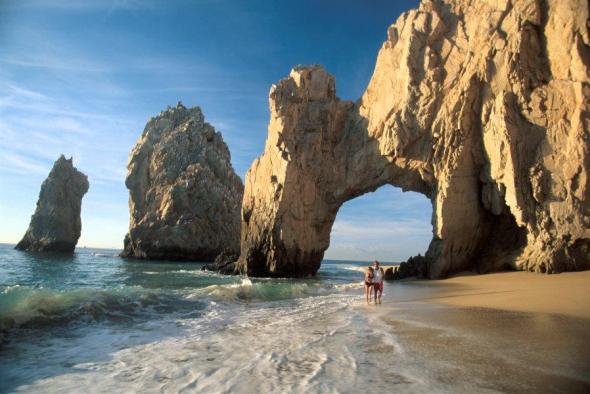Geotourism is geography tourism (as opposed to tourism geography!). It applies to any recreational (tourism) activity where one of the primary objectives is to visit some phenomenon of geographic importance. This could be a coral reef, mangrove swamp, volcano, mountain peak, cave or canyon, but it could just as easily be a sinkhole, waterfall, new town or sugar mill. Ideally, geotourism should be sustainable, ecologically-aware and culturally-sensitive.
Geotourism often involves visiting landforms that hold special value: geomorphosites. Mexico has an amazing diversity of geomorphosites, quite possibly the richest collection of any country in the world.
What exactly are geomorphosites?
Geomorphosites were first defined in 1993 by Mario Panniza. Essentially, they are landforms that have acquired, over time, a certain value. Once noticed and made accessible to people, the landforms acquire scientific, cultural, historical, aesthetic, and socio-economic value. [1]
Panniza subsequently defined geomorphosites as,”landforms that have acquired a scientific, cultural/historical, aesthetic and/or social/economic value due to human perception or exploitation.” [2]
Reynard and Panniza state that geomorphosites can vary in scale from a single geomorphological object (eg a sink hole) to a wider landscape (eg a mountain range) and that geomorphosites “may be modified, damaged, and even destroyed by the impacts of human activities.” [3]
The dominant additional value may be economic, ecological, aesthetic or cultural, and this provides a starting point for assessing whether or not a particular landform is a geomorphosite or not.
The science study (see first comment below!) of geomorphosites is still in its infancy. Several competing classifications have been proposed, and no definitive consensus has yet been reached on the best way to quantify the value of a particular example.
One set of criteria for assessing geomorphosites includes:
A. Economic value:
- accessibility,
- number of visitors,
- inclusion in promotional literature
B. Scientific/ecological value:
- palaeogeographical interest,
- singularity,
- integrity (state of conservation)
- ecological interest
C. Aesthetic value:
- the number and spacing of belvedere points (high points from which a view is possible over the surrounding landscape)
- shape
- altitude
- color
D. Cultural value:
- cultural legacy (writing, art etc),
- historical and archaeological significance,
- religious relevance,
- artistic and cultural events
Mexico has literally thousands of geomorphosites. We have already described some of them, including:
- the world’s smallest volcano in Puebla
- Copper Canyon in Chihuahua
- Paricutín Volcano
- the Basalt Prisms of San Miguel Regla, Hidalgo
- Piedras Encimadas
- El Zacatón sinkhole in Tamaulipas
- Enchanted Lake in Veracruz
and we plan to highlight many more in future posts, including:
- Piedras Bola (Stone Balls) in Jalisco
- Peña de Bernal, a monolith in Querétaro
- Sumidero Canyon in Chiapas
- the iconic marine-eroded arch at Cabo San Lucas (see photo)
The scientific study of geomorphosites should enable researchers to suggest ways to approach their management. Unlimited access to some geomorphosites may generate a healthy flow of admission fees but could also easily increase erosion and hasten the destruction of the very thing that the tourists are paying to see.
On your next trip to Mexico, make sure to visit one or more of the country’s super-numerous geomorphosites!
References:
[1] Comanescu and Nedelea, Area (2010) 42:4, 406-416.
[2] Panizza M. (2001) Geomorphosites : concepts, methods and example of geomorphological survey. Chinese Science Bulletin, 46: 4-6
[3] Reynard, E and Panizza, M. (2005 ) Geomorphosites: definition, assessment and mapping, Géomorphologie : relief, processus, environnement , 3/2005
2 Responses to “Geotourism and geomorphosites in Mexico”
Sorry, the comment form is closed at this time.

I think this is fascinating, and I very much like the categories / classifications and the thought that’s gone into the whole notion and believe there should be a good future in it, especialy when managed with the intelligence shown in this article. What I think is dubious is the phrase “the science of geomorphosites”. I think study would be more appropriate. As a travel writer who is devoted to tourism studies, I still do not consider my field a science and believe I would alienate serious people, as well as scientists by calling tourism a science. It seems to me that what you are starting is a form of tourism that has a scientific interest component, and that in itself is good enough. Best wishes, Barbara
Barbara, Thanks for the kind comments. I entirely agree with your suggestion that “study” is better than “science” and have modified the article accordingly. There is a “science” of geomorphosites, but that is the technical, geological and/or geomorphological side of things. I agree that the “tourism” side of things is more of an art or “social science.” Thanks again for taking the time to comment, Tony